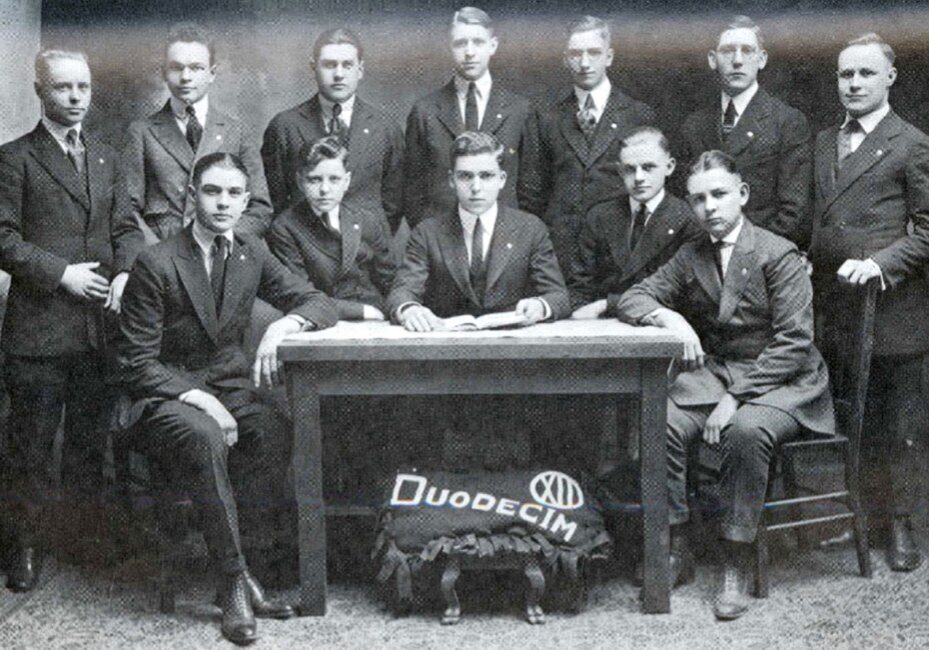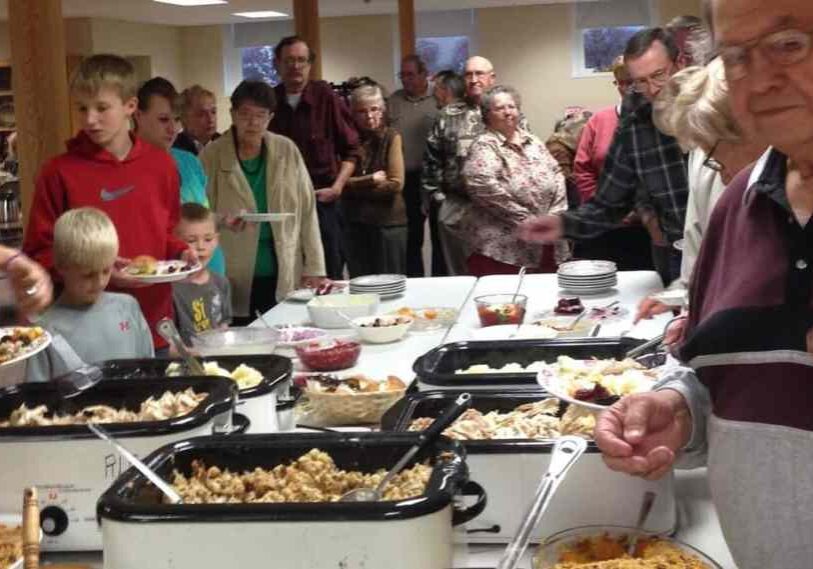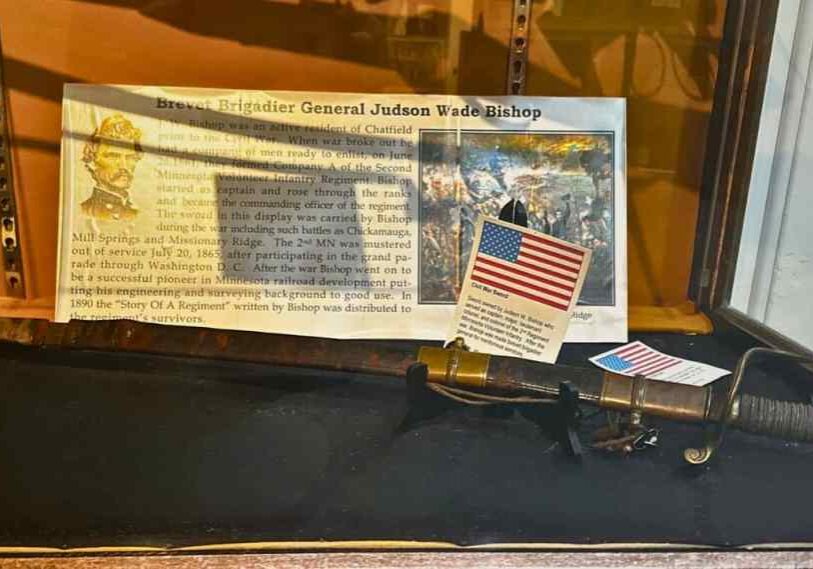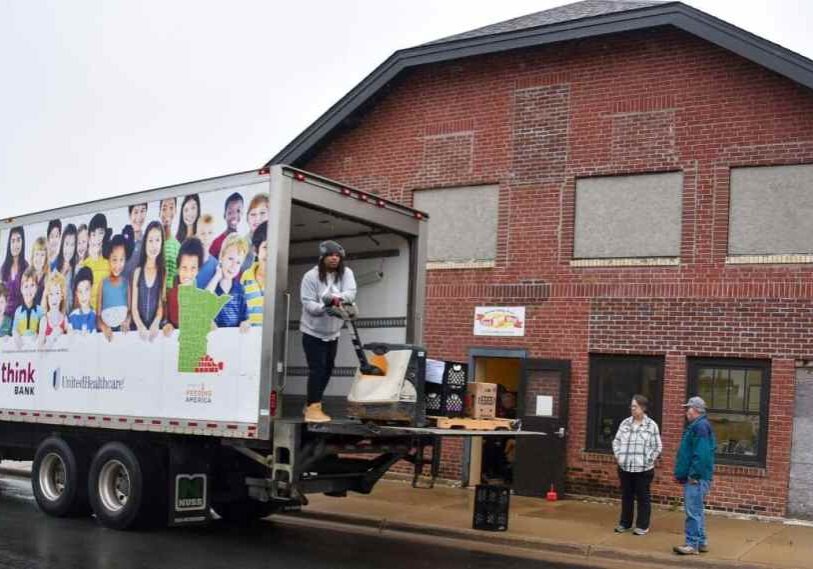Frequent Cemetery Visitor Finds ‘Friends’, Preserves Memories

RACINE – An interest in preserving history has turned into an unusual hobby for Jill Helget of Racine: cleaning headstones in local cemeteries.
The idea came to her while she was traveling on the back roads of the area eight years ago. “I drove by the Hamilton Cemetery, and it really bothered me that some of its headstones looked really bad, so I asked the president there if I could clean and he was shocked,” Helget said.
The shock wasn’t just the novelty of the idea. He also wondered if there were any strings attached as his first question was “how much do you want to get paid?” Most small cemeteries struggle to make ends meet because they need so much upkeep.

The Captain John H. McKenny headstone in the Chatfield Cemetery is transformed. At left is the headstone in the condition Jill Helget found it; the middle view is of Helget working on the headstone; and on the right is the clean 1878 headstone. McKenny, who lived from 1813 to 1878, was a senior editor of the Chatfield Democrat newspaper. On the other side of the stone is wording for his wife, Mary Aletha McKenny, who died in 1882, and their son, Monroe “Roey” Sleeth McKenny, age 3 years. The younger Sleeth’s obituary, below, is from the Chatfield Democrat. (Photo by Jill Helget)

Helget doesn’t get paid for her graveyard cleaning service as she realizes the small cemeteries rely on volunteer help and donations. “It’s my way of giving back to the community,” she said.
Presence expands to more cemeteries
After starting in the Hamilton Cemetery, she went to the Chatfield Cemetery, which is the largest in Fillmore County with about 4,000 burial sites. She has since expanded to: Millet Cemetery, which is east of Racine and north of Spring Valley; Orion, which is near Cummingsville northwest of Chatfield; Spring Valley; Preston; and Phillips Cemetery in rural Lime Springs, Iowa.
She always contacts the cemetery association first to talk to cemetery officials to make sure she has permission to do the work. Word gets around as she has had people thank her while others have made cleaning requests that she fulfills as long as the headstone isn’t too far away.

Jill Helget at the Orion Cemetery in Cummingsville. (Photo by Jill Helget)
Helget estimates she has cleaned at least 5,000 headstones. Two summers ago, she did 500 in the Chatfield Cemetery alone and last summer she did more than 100 in Orion Cemetery. Her headstone cleaning season is from April to about mid-November, depending on the weather.
“On my days off, I just get up in the morning and fill up with water and I go for hours – six to eight hours at a time,” she said.
With all that experience, people now look to her for information. Last year, she made a presentation to the Fillmore County Historical Society during its annual meeting, and she is always willing to share cleaning tips with individuals.
Rolling toolbox aids in demanding physical activity
Once she got the go ahead for her volunteer service, she wanted to make sure she was doing it right. She had watched videos online and followed a person on Facebook, picking up a lot of knowledge about cleaning headstones. “I got tips and tricks on what to do and what not to do,” she said.
Helget said it takes about 15 minutes to an hour, depending on the condition of the headstone, to clean each one.
She started out using just water to clean, but as she became more knowledgeable, she started using D2 biological solution, a non-hazardous biological cleaner developed by conservators to use on everything from buildings to national monuments.

Before and after views of the headstone of Robert Julius Outcalt, who died in 1887 and is buried in the Orion Cemetery, Cummingsville. (Photo by Jill Helget)
Helget uses a variety of brushes that make up a whole kit she can load in a pull-wagon she uses to go from headstone to headstone. She also has two different stools – a higher one and a lower one to make it easier for her to reach the various headstones for cleaning.
“It takes a lot of arm energy,” she added. “I go home and sometimes my arms hurt or my wrists hurt because you scrub a lot.”
She has had people stop and ask her what she is doing. She doesn’t mind the interruptions, though, because often they are family members who talk about the people buried there.
People have also asked her if she has weird encounters, but she has never experienced anything too out of the ordinary. She has seen a lot of fawns while cleaning, and when she visits the Hamilton Cemetery, one deer seems to come out often to check up on her.
Her favorite inscription on a headstone is one of a very young child: “Budded on Earth, Bloomed in Heaven.”
She doesn’t have any system in choosing headstones other than looking for ones that need some attention. “I kind of go for the ones that are in the late 1800s, the really old ones that are just totally covered,” Helget said. “So that’s my go-to, they just kind of call my name.”
She tends to do a lot of military headstones since her husband and four of her children served. That is her focus in the spring, to make sure they are looking good for Memorial Day.

George P. Morris died in 1914 and is buried in the Orion Cemetery, Cummingsville. (Photo by Jill Helget)
More than just cleaning
Helget doesn’t just clean headstones. She also photographs them and digs into the history of each person.
“What a lot of people don’t know is that after I clean the headstones, I go home and I research the person,” she said. “Every headstone I have ever cleaned, I’ve done research on. I’m very big into genealogy.”
She loads the photos of each headstone to Find a Gravestone, an online site that claims it has the largest gravesite collection in the world. The site helps people from all over the world work together to find, record and present final disposition information as a virtual cemetery experience.
Headstones lead to interest in history
Helget grew up in Chatfield. Her father is Roy Lange, one of the well-known twin barbers, which includes Ray of Spring Valley. She has lived in Racine about 25 years. She is a health unit coordinator in the intensive care unit at St. Marys Hospital in Rochester. She has an additional role at night as the ocular procurement technician for the Lions Gift of Sight. When someone who is a donor dies, she takes their eyes for transplant.

Alfred LaFortune died in 1909 at 8 years of age from complications of polio. The headstone in the Chatfield Cemetery features a lamb, which symbolizes innocence and purity. Lambs are often included on headstones of infants or children, representing “Lamb of God.” (Photo by Jill Helget)
The jobs and her unusual hobby keep her busy as she is always on the go.
“My husband always asks, ‘what are you doing today’ and when I say I’m going to see my friends, going to make some new friends today, he knows exactly what I’m doing,” she said.
He is fine with her doing this because he knows it makes her happy, she said. In the process, he has also become more interested in cemeteries, she added. Besides, his father was a gravedigger so he already knew a lot about the type of things she is doing.
Outside of the summer cleaning season, Helget keeps busy on related activities. She is working on a Chatfield Cemetery directory, which is a two-year project. The information will go on the local historical society web page. She really enjoys learning more about Chatfield’s history since that is where she grew up.
“It’s nice to know where we came from,” she said.
This past year, she finished a family heritage book for someone she knows. She has also done her own book as well as a book for a cemetery in Iowa that had no previous information. She now serves on the Chatfield and Hamilton cemetery boards as well as on the board of the Fillmore County Historical Society.
However, she always looks forward to the warmer weather so she can visit her “friends” at local cemeteries. Cleaning headstones is a process that she says is not only relaxing but also rewarding.
“It’s just basically that when I die, I want somebody to remember me,” Helget said. “Even if it’s for the short time I’m cleaning the headstone, and looking the person up, at least they’re being remembered. I guess that is my whole way of thinking about it.
“A lot of people think it’s weird that I do it, but, you know, we’ve all got our quirks.”
Jill Helget is not the only area person fascinated with cemeteries and their history. Read Honoring the Past Through Service Today to see how volunteers are working together to maintain the Watson Creek Cemetery, west of Preston.






